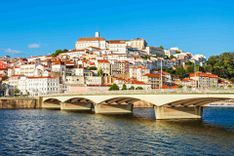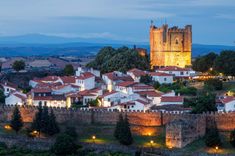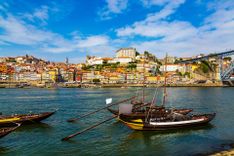Best places in Portugal to visit
From icons to hidden treasures
















Plan and book with vetted local experts
Fill out a short form
Collaborate, refine, and choose your best fit
And travel with 24/7 concierge service
Discover what makes Portugal unforgettable





Portugal’s beaches are simply stunning. The Algarve features dramatic cliffs and hidden coves, perfect for sunbathing and swimming in crystal-clear waters. Towns like Lagos and Albufeira offer vibrant atmospheres with charming cafes and shops. If you’re a surfer, Nazaré’s giant waves are legendary. For a more peaceful vibe, check out the serene beaches of Comporta, where you can unwind and soak in the breathtaking scenery.


Beyond the beaches, Portugal’s landscapes are incredibly diverse. You’ve got the lush, green mountains in the Azores, the rolling hills of the Alentejo, and dramatic cliffs along the coastline. Whether you’re hiking, cycling, or just taking in the scenery, Portugal’s natural beauty will leave you speechless.


Portugal’s architecture is a mix of medieval, Moorish, and modern influences. You’ll find Gothic monasteries, ornate Manueline-style buildings, and contemporary designs by world-renowned architects. Whether you’re visiting the ancient Jerónimos Monastery or the modern MAAT museum, the blend of old and new is stunning.


Portugal’s famous blue-and-white tiles—azulejos—adorn buildings, churches, and even train stations. These hand-painted tiles tell stories through intricate designs, adding character to the streets. You can explore Lisbon’s tile museum or just wander the streets and admire the art all around you.

Plan with confidence
Meet the experts who make your journey special
Meet the experts who make your journey special
See all Portugal local experts →









Rough Guides gets rave reviews
Trustpilot Rated 4.8/5.019/09/2025
Rough Guides listened and understood what I wanted out of a holiday. From Sara, who started the process, to Monica Mendes from Be in Travel Portugal who perfected the trip details, everything went brilliantly. The private walking guides were excellent with particular reference to Maria Joao Matos in Evora. In hindsight, doing a self drive road tour, I should have elected to spend more than two nights in some of the smaller towns like Evora and Tomar. Distances are not great when accessing the good freeway system. Driving only becomes a problem if staying in the smaller places in the old parts of the town where to get a parking spot near accommodation is almost impossible and the streets are so narrow that on occasions had to turn in the side mirrors. Another difficult with self drive is the drop off at Lisbon airport - a nightmare. Our holiday in Portugal with the guidance of Rough Guides and Be in Portugal was wonderful. All the hardwork of planning a trip with accommodation, driver pickups from airports, guides and 24hour help line if needed taken care of made for a top class holiday
17/05/2025
My Travel Ladies (6 in total, all over 70) and I spent 10 days with Joel throughout Portugal, and we all felt it was simply excellent. I started working with Joel in August and nailed down our trip. We discussed sites important to us, where we wanted a guide, and hotel levels. His suggestions were spot on and we could not have been happier. I recommend him for his kindness, his communication and overall ability to meet our needs. Joel has a beautiful sense of humor that blended with all of us. My one wish is that I could work with him on our next adventure but, we all now feel Portugal is like a second home. Beautiful trip!
13/04/2025
Our guide (Joel) set up a perfect 10 day itinerary for us in Portugal-based on our requests. He was available at all times if we needed anything. Our tours were with small groups (ideal) and all set up for us. The hotels were also wonderful. We will definitely use Rough Guides in our future travel.
25/09/2024
Itinerary fitted our needs. Travel book was very useful and well put together. Joel (our host) was always available and easy to reach and provided good advice as well as addressing last minute requests for changes.
20/09/2024
We had a great time. Joel was a wonderful host and took great care of us. He was knowledgeable and friendly. We enjoyed our time with him. The trip went very well. All the accommodations were more than we expected, and the sights/events chosen gave us a full view of Portugal. I would whole-heartedly recommend Rough Guides and Joel for anyone considering Portugal. The only suggestion I would make is that an electric vehicle is not the best choice for long car rides. To manage the battery life, we had to go very slow, but we did enjoy our time with Joel on the drives. Electric is great for short visits like Sintra and Belhem, but for the longer drives the technology is not yet there.
11/09/2024
Traveled to Portugal and Joel with Rough Guides was amazing. He planned our trip and was our driver too. He’s very friendly and loves his country. We felt we made a friend in the 10 days we were there. Loved our trip.
From icons to hidden treasures
















Discover Portugal's most captivating stories
Arrange your trip, hassle-free, with local travel experts
Arrange your trip with local travel experts